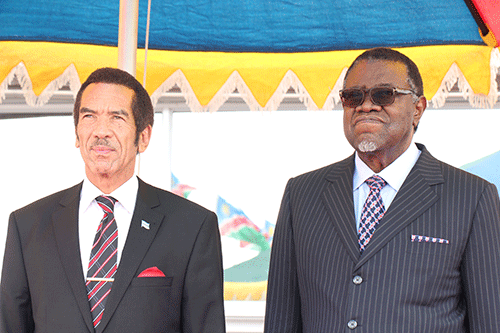National Unity Democratic Organisation’s parliamentarian Josef Kauandenge has moved to discuss the signed Namibia-Botswana Boundary Treaty of 2018.
On 5 February 2018, President Hage Geingob and former Botswana president Ian Khama signed a border treaty that saw Namibia cede Situngu Island to Botswana.
There have been accusations from some opposition and some citizens from the Zambezi region, including chiefs, alleging there was no consultation before the conclusion of the 2018 Boundary Treaty between Namibia and Botswana.
Of particular concern, the Mafwe and Mayeyi traditional authorities are refusing to recognise the legality of such a treaty. They reasoned that their communities are living in constant fear, as the neighbouring country increases military activity along the Chobe River. The traditional leaders claim to have learnt about this only through the media.
Giving notice in parliament on Tuesday, Kauandenge implored fellow lawmakers to withdraw the treaty on the basis of unconstitutionality and, therefore, reverse the President’s notification of the treaty by resolution in terms of Article 32(a) of the Namibian Constitution.
He said Article 5 of the constitution imposes upon the August House the duty to respect and protect fundamental rights and freedom entrenched in the Bill of Rights, which includes the right to administrative justice and the right of property.
According to Kauandenge, the Namibian government was advised by the African Commission on Human and People’s Rights (ACHPR) not to sign the boundary treaty, but in disregard of the advice, Namibia and Botswana went ahead and signed.
Also, he said the Commission of the African Union/Department of Peace and Security suggested in 2015 that “sensibilities of local communities” inhabiting areas along and across the boundary alignment should be taken into account in order to “make a difference” between delimitations or demarcations done in the context of the (AU) African Border Programme.
“The general rule is that any conduct or decision taken unlawfully or which has an effect that is not consistent with the constitution, is unlawful and should be lawfully set aside or reversed,” he said.
“I plead with you honourable members that should it be clear to all of us that one or more elements leading to or resulting from ratification of the boundary treaty is, or are, inconsistent with the constitution of Namibia and the international law, let us resolve to defend and protect the supremacy of the constitution and the principal of the rule of law without fear or favour by involving Article 34 (a) of the constitution,” he added.
In May last year, government refuted widespread allegations that no consultation took place with the Zambezi inhabitants regarding the signed border treaty.
Safety and security minister Albert Kawana defended the government’s position that from the beginning to the end, the process was transparent and in line with the letter and spirit of the Namibian constitution.
Kawana also said before the conclusion of the border treaty, the Namibian government and that of Botswana agreed to numerous terms of reference, including establishing a joint commission of technical experts on the delimitation and demarcation of the boundary between Botswana and Namibia along the Kwando/Linyanti/Chobe rivers, signed by the contracting parties on 24 November 1999.
The main purpose of the joint commission was to delimit and demarcate the boundary between Botswana and Namibia along the three rivers in terms of the Anglo-German Agreement of 1 July 1890.
Before the inaugural meeting of the joint commission of technical experts, Kawana noted consultation meetings were held with the then three traditional authorities, namely the Masubia, the Mafwe and the Mayeyi
“The involvement of the traditional authorities was also coordinated with the honourable governor of Zambezi (then Caprivi region), Bernard Songa Sibalatani. In contrast with the boundary along the Zambezi River, which was properly delimited and then demarcated around 1933, the Kwando/Linyanti/Chobe rivers boundary was not demarcated. The demarcation of the Zambezi River boundary identified 33 islands,” Kawana explained at the time.
In compliance with the constitutional requirements, the National Assembly on 12 June 2018 unanimously agreed to the ratification of the boundary treaty.


